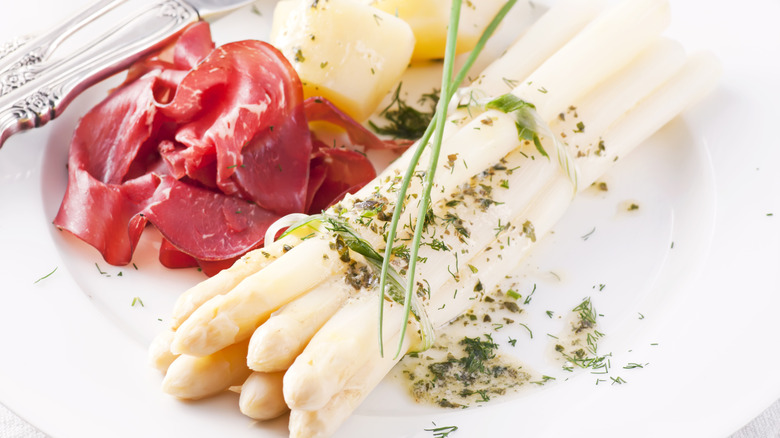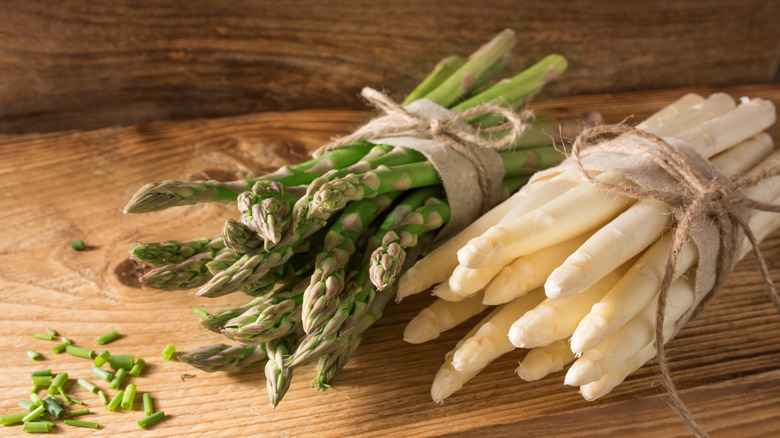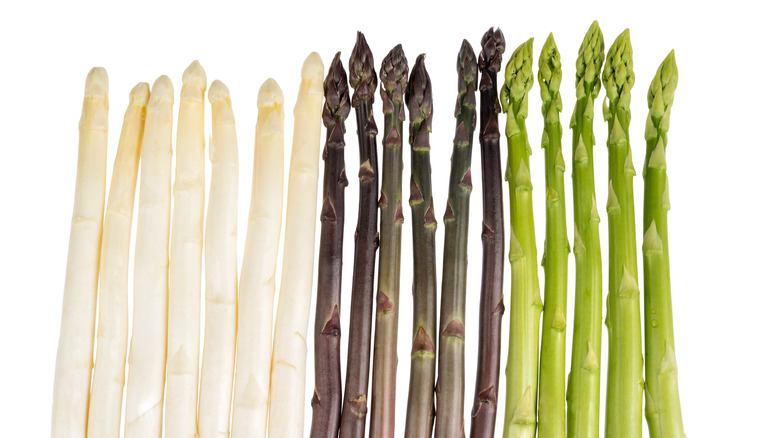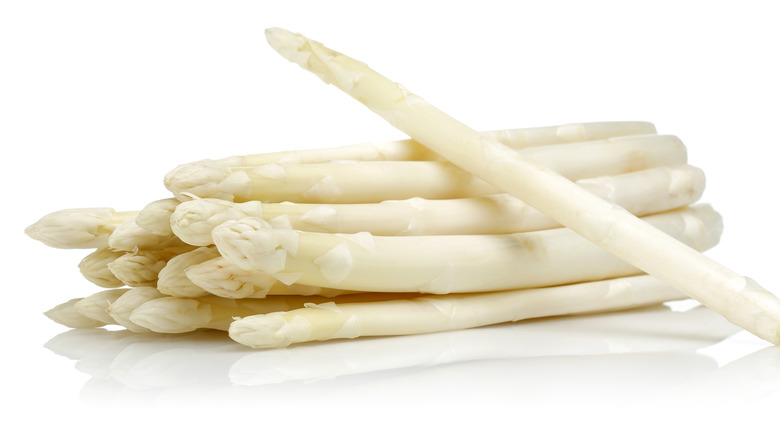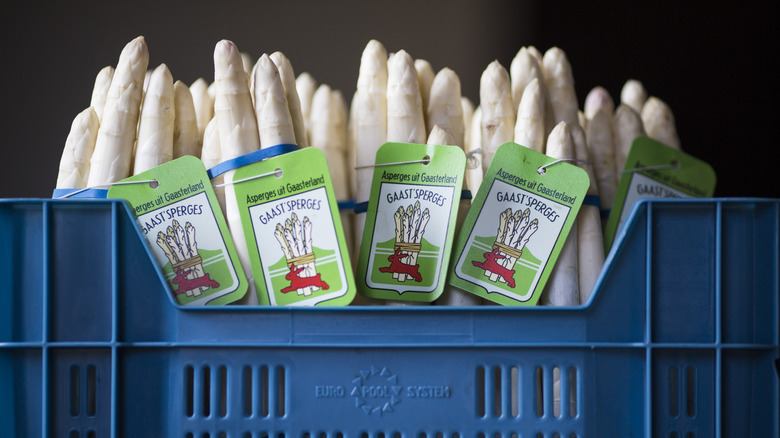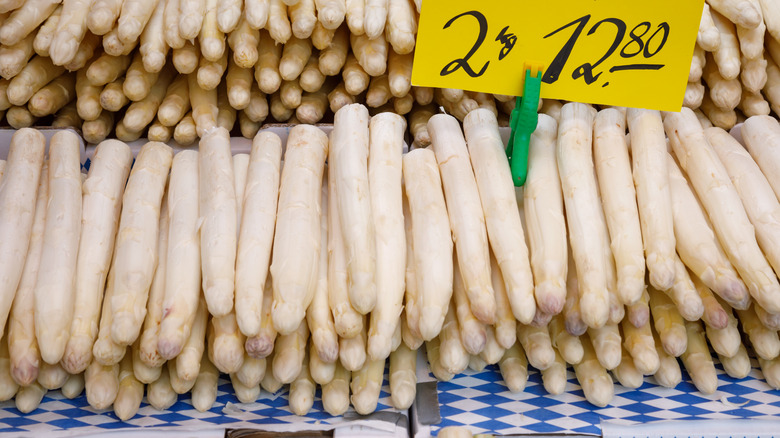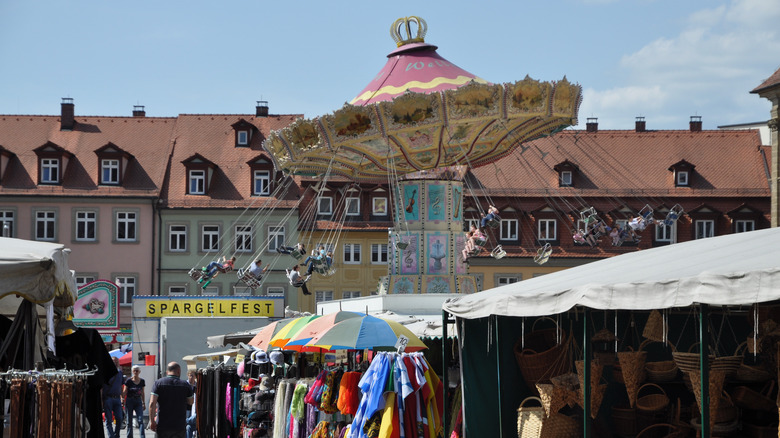What Is White Asparagus And How Does It Differ From Other Varieties?
Spring means many things to different people: longer days, the first buds of royal purple crocuses peeking up from the ground, or an opportunity to flaunt an entire new wardrobe of pastels. But for the Germans, spring means one thing — the beginning of Spargelzeit.
The German compound word refers to "asparagus season," but specifically it refers to white asparagus, which is so beloved that it is often called "white gold." The vegetable has a short season and is rather difficult to grow, making it expensive and highly prized. In Europe, dedication to seasonality in food is a religion, and you won't find the same breadth of hothouse fruits and imported vegetables that line the shelves of American grocery stores in the winter. So the springtime asparagus season is extra important because it marks the end of the dreary German winter, during which markets are filled with twenty different kinds of cabbage, and little else in the way of greenery.
But what exactly is this strange-looking vegetable, and why does it inspire such a rabid fanbase?
White asparagus vs. green asparagus
White asparagus looks a lot like your garden variety green asparagus, if someone had bleached all the color out of it. It is often thicker and woodier than green asparagus, with its long, white stalks dipped in pale purple at the tips. (Asparagus can be purple too, by the way, making that its third color.)
It's actually the same plant variety as green asparagus, but it is treated in a different manner as it is growing, through a process called etiolation. Farmers cover the spears in the dirt as they continue to grow, and cover them in a black plastic tarp.
This means that white asparagus never sees sunlight, so it fails to develop the chlorophyll that gives green asparagus its color. Because asparagus grows so fast, it also means that this is a labor-intensive product to grow, resulting in a higher price point. Where green asparagus might run for $3.99 per pound at a U.S. grocery store, white asparagus could cost $5.99 per pound.
What does white asparagus taste like?
The flavor of white asparagus is much more delicate than that of green asparagus. Instead of bold, grassy notes, white asparagus gives off a subtle sweetness with just a bit of bitterness to balance it out. It is not as sweet, however, as purple asparagus, a cultivated asparagus variety that is green on the inside and loses its exterior color when cooked.
The difference in flavor between white and green asparagus can most easily be explained as the difference in flavor between cauliflower and broccoli. Though similar in texture and structure, their taste doesn't jump out in the same way, and their flavors must be coaxed out through a longer cooking process.
How to cook with white asparagus
Throughout Germany, white asparagus is served alongside regional favorites like schnitzel, bratwurst, or potatoes, used to spruce up soups and salads, or drizzled with hollandaise sauce. But it is most commonly served simply with butter and ham, per The Guardian.
This variety requires a little more effort to cook than green asparagus, however. Because its texture is much denser and not as juicy as green asparagus, white asparagus must be trimmed and shaved down to remove its thick outer skin. (The Germans have even invented asparagus peeling machines specifically for this task.)
It is often cooked in an emulsion of water, butter, lemon juice, and salt, and simmered for up to thirty minutes to make it soft enough to eat without resulting in a stringy, chewy mess. White asparagus can also be steamed, roasted, or grilled, and is absolutely delicious pickled, which is a godsend considering its short season. Consider serving it alongside wine from the region where white asparagus is grown, such as a dry Riesling.
Is white asparagus good for you?
White asparagus shares a lot in common with green asparagus, in terms of nutrition, and both are generally considered to be part of a healthy diet. White asparagus has double the vitamin C, but half the vitamin A of green asparagus, cup for cup. It is rich in flavonoids, which have antioxidant and anti-inflammatory properties. It is higher in fiber than green asparagus due to the growing process, and white asparagus has a prebiotic effect on the body.
A serving size of white asparagus is about five spears, or ⅔ cup, which only amounts to approximately 15 calories, comparable to green asparagus. It is high in vitamin K, which is good for the heart, low in fat (0g per serving), and contains about 1.5g of fiber and 2.31g of carbohydrates, about the same as green asparagus. However, white asparagus does have a slightly lower protein count (1.54g), and fewer antioxidants and vitamin E than green asparagus.
Where and when to buy white asparagus
Spargelzeit mirrors the season of the more common green asparagus, and is just as brief, beginning in the middle of April and ending on exactly June 24 every year. The season starts with the first touch of spring and ends with the celebration of the Nativity of John the Baptist. While it might be sold at grocery stores, you are much more likely to find it at farmer's markets, where starstruck customers wait patiently in line for their chance to beg local growers for the best of the batch.
In addition to Germany, white asparagus is popular in France, Switzerland, and the Netherlands. It may be found in the United States if you know where to look, but white asparagus bought in America is likely imported from Peru. Pickled white asparagus, however, can be found year-round in grocery stores throughout the world, from popular brands like Landsberg and Roland.
Germany's obsession with white asparagus
Germans eat about 138,000 tons of white asparagus every year, but its popularity goes beyond culinary interest and has expanded into an entire cultural phenomenon. Saveur details the pomp and circumstance surrounding the annual crowning of the Spargel Prinzessin, or Asparagus Princess, in the medieval German town of Nienburg in Lower Saxony. The position is no joke, as the Asparagus Princess is usually a farmer's daughter with a strong connection to the vegetable, and will spend the entirety of the season promoting the production of the region.
Along the Spargelstrasse, or Asparagus Road, which grows the most asparagus in all of Germany, is home to a Spargel museum, a Spargel fountain, and of course a Spargelfest. Festivals can include everything from parades to live music, and from an asparagus peeling contest to food stands where the vegetable can be enjoyed in its many forms. If you're farther east, near Berlin, you can visit the Spargelstadt (Asparagus City) of Beelitz in Brandenburg.
